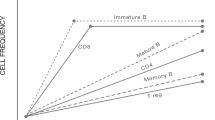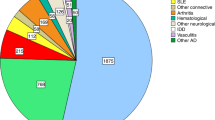Abstract
BMT can both transmit and eliminate autoimmune diseases, and hence it has been suggested as an optional treatment for severe autoimmune conditions. In this communication we deal with the question of whether chronic GVHD is an autoimmune disease in itself, review the literature reports of autoimmune diseases following BMT in humans, and describe the autoimmune nature of the post-BMT state. Chronic GVHD, which is a frequent complication post-BMT, has clinical and pathogenic characteristics similar to autoimmune diseases, such as scleroderma and Sjogren’s syndrome. Although the pathogenesis of chronic GVHD is not yet clear, thymic damage induced by acute GVHD may contribute to both the immunodeficiency and autoimmunity characterising chronic GVHD. A similar phenomenon is syngeneic GVHD, which results from an imbalance between autoreactive and autoregulatory lymphocytes. Additionally, other autoimmune diseases have been reported in post-BMT patients, and among these the most common are hypothyroidism, hyperthyroidism, myasthenia gravis and immune cytopenias. Although these diseases also occur also outside the post-BMT setting, they are unique with respect to pathogenesis (no association between myasthenia gravis and thymic pathology), diagnosis (symptoms of hyperthyroidism may be inadvertently related to other conditions), and prognosis (post-BMT autoimmune cytopenias may be fatal and treatment non-responsive). Nevertheless, many other autoimmune diseases have been reported after BMT, and these are mainly presented as case reports. Regarding the mechanism of post-BMT autoimmunity, the minority of cases stem from donor-related transfer of pathogenic lymphocytes or their progenitors, while most of the cases (either chronic GVHD or specific diseases) can be attributed to the immunologic imbalances characterising the post-BMT setting. The factors that may expose an individual to autoimmunity development post-BMT include genetic predisposition, an environmental factor such as CMV, and the nature of the donor who may aid in creating microchimerism and subsequently chronic GVHD and its related autoimmune manifestations.
This is a preview of subscription content, access via your institution
Access options
Subscribe to this journal
Receive 12 print issues and online access
$259.00 per year
only $21.58 per issue
Buy this article
- Purchase on Springer Link
- Instant access to full article PDF
Prices may be subject to local taxes which are calculated during checkout
Similar content being viewed by others
Author information
Authors and Affiliations
Rights and permissions
About this article
Cite this article
Sherer, Y., Shoenfeld, Y. Autoimmune diseases and autoimmunity post-bone marrow transplantation. Bone Marrow Transplant 22, 873–881 (1998). https://doi.org/10.1038/sj.bmt.1701437
Received:
Accepted:
Published:
Issue Date:
DOI: https://doi.org/10.1038/sj.bmt.1701437
Keywords
This article is cited by
-
New autoimmune diseases after autologous hematopoietic stem cell transplantation for multiple sclerosis
Bone Marrow Transplantation (2021)
-
Vitiligo following stem-cell transplant
Bone Marrow Transplantation (2020)
-
Blood Group Discrepancy-First Sign of Autoimmune Hemolytic Anemia after Hematopoietic Stem Cell Transplantation in a Child
Indian Journal of Hematology and Blood Transfusion (2016)
-
Polyclonal gammopathy after BKV infection in HSCT recipient: a novel trigger for plasma cells replication?
Virology Journal (2015)
-
Transmission of psoriasis by allogeneic bone marrow transplantation and blood transfusion
Blood Cancer Journal (2015)



